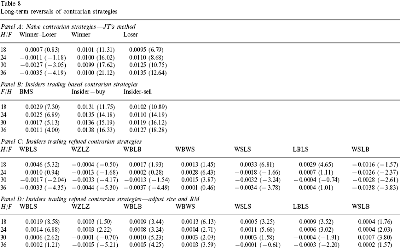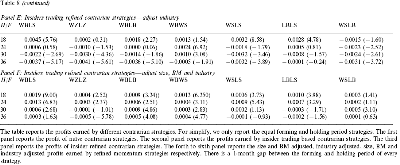In this paper, we studied influence and explanatory power of insiders trading activities on momentum effects of stocks in USA market during the period January 1985–November 1996. We interpret our findings as that the continuous overreaction is the source of mediate term momentum effects and also the seed of long run reversals.
Our explanation is based on previous irrational model and experimental psychology findings. Investors continuously overreact when they observe that the past return performance is consistent with their initial observations on insiders trading activities. The continuous overreaction is the source of momentum strategies and long-term reversals. Our results should be partially consistent with Daniel et al. (1998)’s model. Further study shows that the risk factors such as size and BM cannot explain the momentum effects.
We also studied the explanatory power of industry factors on our refined momentum strategies. The results show that the industry factor also cannot explain the profits earned by the refined momentum strategies. In summary, the paper contributes to the existing literatures in these aspects. First, momentum effects exist among stocks in NYSE, AMEX and NASDAQ during the period January 1985–November 1996. Second, the insiders trading activities contain valuable information and can predict the cross-sectional stock returns.
The insiders trading based momentum strategies can even earn positive profits as long as holding for 36 months, which is different with naı¨ve momentum strategies. Third, the insiders trading information can be used to strengthen naı¨ve momentum effects. The refined momentum strategies can earn a much higher profit. The size and BM factors cannot explain the momentum effects. Further study shows that the industry factor cannot explain the refined momentum effects. We propose an irrational explanation on the momentum effects: continuous overreaction caused by self-attribution bias.
It is hard to use the rational asset pricing model to explain the findings in the paper. Although there is still not a widely accepted irrational model, we believe that the reactions of market participant may not be as rational as we assumed. Just as a simple psychology test showed, most people in the world believe that they are above average, but as we know, only half can be above average.
Acknowledgements
We thank the anonymous referees, Fariborz Moshirian and Antonio Wong. The paper was presented at the 14th Annual Australasian Finance and Banking Conference at Sydney.
Jihong Xiang, Jia He , Min Cao
Next: References
Summary: Index

